Stan C. Smith's Blog
October 10, 2025
In our neck of the woods... the beautiful but little known passion flower.
We're lucky to have quite a few of these amazing plants growing wild on our property. I had never heard of them until we moved here six years ago.
These plants are vines that climb on other plants, but rarely more than about six feet high. The flowers are stunning and exotic-looking, yet they are native to Missouri and much of the eastern United States. The flowers are awesome, and the resulting fruits are delicious. The fruits are sometimes called Maypops because when the fruits ripen (in May in southern locations), they pop loudly when you squeeze them. Anyway, inside the fruits are a bunch of seeds coated with delicious sweet gooey stuff (kind of like pomegranates). When Trish and I find these when we are on a walk, we pop them open, slop the seeds into our mouths, and suck all the gooey goodness off before spitting out the seeds.
Passion flowers got their name when early Spanish missionaries came to the Americas and came up with the idea that certain aspects of the flower represented Christ's crucifixion (referred to as the "passion").
These flowers are great for attracting butterflies and hummingbirds. They also have a long history of medicinal uses, to relieve anxiety, insomnia, pain, epilepsy and high blood pressure. Anyway, I just like the beauty of the flowers and the yumminess of the gooey fruits.


Photo Credits:
- Passion flower - Stan C. Smith
- Passion flower with fruit - DepositPhotos
These plants are vines that climb on other plants, but rarely more than about six feet high. The flowers are stunning and exotic-looking, yet they are native to Missouri and much of the eastern United States. The flowers are awesome, and the resulting fruits are delicious. The fruits are sometimes called Maypops because when the fruits ripen (in May in southern locations), they pop loudly when you squeeze them. Anyway, inside the fruits are a bunch of seeds coated with delicious sweet gooey stuff (kind of like pomegranates). When Trish and I find these when we are on a walk, we pop them open, slop the seeds into our mouths, and suck all the gooey goodness off before spitting out the seeds.
Passion flowers got their name when early Spanish missionaries came to the Americas and came up with the idea that certain aspects of the flower represented Christ's crucifixion (referred to as the "passion").
These flowers are great for attracting butterflies and hummingbirds. They also have a long history of medicinal uses, to relieve anxiety, insomnia, pain, epilepsy and high blood pressure. Anyway, I just like the beauty of the flowers and the yumminess of the gooey fruits.


Photo Credits:
- Passion flower - Stan C. Smith
- Passion flower with fruit - DepositPhotos
Published on October 10, 2025 07:32
October 1, 2025
Life's great mysteries - Is there a limit to how intelligent a single person can be?
There's no end to the weird questions I ponder. But seriously… how intelligent can an individual person get? Are there biological or physical limits? This question doesn’t have a simple answer. But, hey… I don’t call these Life’s Great Mysteries for nothin’. Let’s dig in.
Some researchers believe human intelligence has no limits. To me, this seems rather far-fetched, but let’s consider the arguments. These researchers argue that their computer models of brain function show that human thought can endlessly generate new deductions and inferences… as long as cognitive processes persist. In other words, if a human could live forever, without ever experiencing cognitive degradation, there may be no limit to increasing intelligence.
Well then, it seems to me that the human lifespan, and more importantly, the cognitive decline as we age, automatically limits intelligence.
Anyway, despite what I said above, most research seems to indicate there are biological and physical limits to human intelligence. For example, the size of the human brain already pushes the limits of what can fit through the birth canal during childbirth. I suppose human females could evolve larger birth canals to accommodate larger brains (obviously, they already have, right?). But some scientists think, as bipedal creatures, we’ve already hit that limit (much larger birth canals would impede walking and running).
Okay, so maybe our brains can’t get much larger. But what if our brains developed more densely-packed neurons, or our neurons developed a way to transmit signals even faster? Unfortunately, due to the nature of neurons, there seems to be physical limits to both of these possibilities, and human brains (as well as brains of other animals) may have already reached these limits long ago. As adults, our brains already use 20% of the calories we consume, even though the brain is only 2% of our body weight. And with children, the brain can consume up to 65% of the body’s energy! Could our bodies even support a brain that requires much more energy?
Where does this leave us? Have we reached the limit of human intelligence? Maybe. When it comes to the impact of artificial intelligence (AI), I can see two arguments: Some people might suggest augmenting our own intelligence with AI will take us to the next level. Other people might suggest our reliance on AI will result in no need for our brains to continue evolving, and therefore we have already stalled out.
My opinion? I’ll use the words of Dr. Ian Malcolm (from Jurassic Park): Nature finds a way.

Photo Credits:
- Cloud brain - Midjourney 7
Some researchers believe human intelligence has no limits. To me, this seems rather far-fetched, but let’s consider the arguments. These researchers argue that their computer models of brain function show that human thought can endlessly generate new deductions and inferences… as long as cognitive processes persist. In other words, if a human could live forever, without ever experiencing cognitive degradation, there may be no limit to increasing intelligence.
Well then, it seems to me that the human lifespan, and more importantly, the cognitive decline as we age, automatically limits intelligence.
Anyway, despite what I said above, most research seems to indicate there are biological and physical limits to human intelligence. For example, the size of the human brain already pushes the limits of what can fit through the birth canal during childbirth. I suppose human females could evolve larger birth canals to accommodate larger brains (obviously, they already have, right?). But some scientists think, as bipedal creatures, we’ve already hit that limit (much larger birth canals would impede walking and running).
Okay, so maybe our brains can’t get much larger. But what if our brains developed more densely-packed neurons, or our neurons developed a way to transmit signals even faster? Unfortunately, due to the nature of neurons, there seems to be physical limits to both of these possibilities, and human brains (as well as brains of other animals) may have already reached these limits long ago. As adults, our brains already use 20% of the calories we consume, even though the brain is only 2% of our body weight. And with children, the brain can consume up to 65% of the body’s energy! Could our bodies even support a brain that requires much more energy?
Where does this leave us? Have we reached the limit of human intelligence? Maybe. When it comes to the impact of artificial intelligence (AI), I can see two arguments: Some people might suggest augmenting our own intelligence with AI will take us to the next level. Other people might suggest our reliance on AI will result in no need for our brains to continue evolving, and therefore we have already stalled out.
My opinion? I’ll use the words of Dr. Ian Malcolm (from Jurassic Park): Nature finds a way.

Photo Credits:
- Cloud brain - Midjourney 7
Published on October 01, 2025 11:52
September 27, 2025
Loons and Monarchs.
As I've mentioned, Trish and I recently returned from and fun adventure up north (Superior National Forest in Minnesota and the UP of Michigan).
One of our favorite animals in the north woods is the common loon. These fish-eating predators are often seen floating in the lakes and diving under to catch fish. They can stay underwater for a surprisingly long time. Underwater, they dart around like torpedoes, using their huge webbed feet to propel them. They are fast enough to catch fish, but they also eat crayfish.
The call of the loon is hauntingly beautiful... a long, drawn-out, lonely sounding howl. Loons often do this at night, then you'll hear another loon, perhaps floating on another lake in the distance, return the call. It's almost like they're lonely, and they just want to make sure other loons know they are there. I took this loon photo from the porch of our rustic cabin.
After a week of paddling (and hiking) in Minnesota, we drove over to the Upper Peninsula of Michigan to visit some good friends. We were lucky to be there at the time of the monarch butterfly migration. Monarchs heading south from Canada must fly nonstop across vast Lake Michigan, which could be as much as 280 miles over open water if the butterflies head straight south. Anyway, many monarchs fly to the tip of a certain peninsula, and they pause there to rest and to consume as much nectar as they can before taking off across the massive lake. We drove to the point to see them and were not disappointed. Thousands of monarchs had gathered there, getting themselves psyched up for hopping over the pond.


One of our favorite animals in the north woods is the common loon. These fish-eating predators are often seen floating in the lakes and diving under to catch fish. They can stay underwater for a surprisingly long time. Underwater, they dart around like torpedoes, using their huge webbed feet to propel them. They are fast enough to catch fish, but they also eat crayfish.
The call of the loon is hauntingly beautiful... a long, drawn-out, lonely sounding howl. Loons often do this at night, then you'll hear another loon, perhaps floating on another lake in the distance, return the call. It's almost like they're lonely, and they just want to make sure other loons know they are there. I took this loon photo from the porch of our rustic cabin.
After a week of paddling (and hiking) in Minnesota, we drove over to the Upper Peninsula of Michigan to visit some good friends. We were lucky to be there at the time of the monarch butterfly migration. Monarchs heading south from Canada must fly nonstop across vast Lake Michigan, which could be as much as 280 miles over open water if the butterflies head straight south. Anyway, many monarchs fly to the tip of a certain peninsula, and they pause there to rest and to consume as much nectar as they can before taking off across the massive lake. We drove to the point to see them and were not disappointed. Thousands of monarchs had gathered there, getting themselves psyched up for hopping over the pond.



Published on September 27, 2025 07:15
September 18, 2025
North Woods Adventure
Trish and recently returned from a week in the north woods of northern Minnesota (for canoeing). I have many stories to share, but today I'll start with a hike we took in Superior National Forest in Minnesota between our paddling adventures.
We pulled over at the trailhead of the Magnetic Rock Trail. The trail is only three miles, and was supposed to be an easy hike. Well, it wasn't quite as easy as we imagined, and three miles can seem like a long distance when you are stepping over countless boulders and bushwhacking around fallen trees. So it ended up taking more than three hours.
The destination was an odd sixty-foot-high rock that glaciers had deposited in this vertical position instead of flat on the ground.
And the rock is magnetic. We took compasses with us, and when we held them up near the rock's surface, the needles went wacky.
How does such a magnetic rock form? Some rocks contain minerals that contain iron and act like tiny magnets. A LONG time ago, these minerals began to form as the lava (or magma) cooled. While the molten rocks had not yet solidified, the magnetic minerals floating in it became aligned to the Earth's magnetic field. Then, as the rocks solidified, these aligned minerals became locked in place. This can also happen with sedimentary rocks, but instead of floating in molten rock, the tiny minerals are deposited at the bottom of a body of water, and while they are still loose, they become aligned to the earth's magnetic field. Eventually, these sedimentary layers solidify into magnetic rock. Rock on!
As we hiked back to our vehicle, we noticed two ruffed grouse (grouses?) feeding on plants beside the trail. I only had my phone for a camera, so I crept closer. And then closer. And even closer. For whatever reason, these birds seemed totally unafraid of us. Finally, I held my phone about two feet away from one to take this photo.
Ruffed grouse don't live in Missouri, so this close encounter was rather exciting to me (it doesn't take much to excite me). Ruffed grouse are perhaps best known for the "drumming" behavior of males. Male grouse are aggressively territorial, and to proclaim their ownership of a section of forest, they stand on a log or rock (which is usually about twelve inches off the ground) and beat their wings really fast. So fast, in fact, that the motion creates a vacuum with each beat (as lightning does when it creates thunder). This makes a series of surprisingly loud drumming sounds.


We pulled over at the trailhead of the Magnetic Rock Trail. The trail is only three miles, and was supposed to be an easy hike. Well, it wasn't quite as easy as we imagined, and three miles can seem like a long distance when you are stepping over countless boulders and bushwhacking around fallen trees. So it ended up taking more than three hours.
The destination was an odd sixty-foot-high rock that glaciers had deposited in this vertical position instead of flat on the ground.
And the rock is magnetic. We took compasses with us, and when we held them up near the rock's surface, the needles went wacky.
How does such a magnetic rock form? Some rocks contain minerals that contain iron and act like tiny magnets. A LONG time ago, these minerals began to form as the lava (or magma) cooled. While the molten rocks had not yet solidified, the magnetic minerals floating in it became aligned to the Earth's magnetic field. Then, as the rocks solidified, these aligned minerals became locked in place. This can also happen with sedimentary rocks, but instead of floating in molten rock, the tiny minerals are deposited at the bottom of a body of water, and while they are still loose, they become aligned to the earth's magnetic field. Eventually, these sedimentary layers solidify into magnetic rock. Rock on!
As we hiked back to our vehicle, we noticed two ruffed grouse (grouses?) feeding on plants beside the trail. I only had my phone for a camera, so I crept closer. And then closer. And even closer. For whatever reason, these birds seemed totally unafraid of us. Finally, I held my phone about two feet away from one to take this photo.
Ruffed grouse don't live in Missouri, so this close encounter was rather exciting to me (it doesn't take much to excite me). Ruffed grouse are perhaps best known for the "drumming" behavior of males. Male grouse are aggressively territorial, and to proclaim their ownership of a section of forest, they stand on a log or rock (which is usually about twelve inches off the ground) and beat their wings really fast. So fast, in fact, that the motion creates a vacuum with each beat (as lightning does when it creates thunder). This makes a series of surprisingly loud drumming sounds.


Published on September 18, 2025 09:06
September 13, 2025
In our neck of the woods... Cool Moths
A couple of really cool moths showed up at our house recently. Trish spotted this first creature feeding on the nectar of our marigolds. From a distance, the way it hovers and darts left and right makes it look very much like a hummingbird. In fact, one of its names is hummingbird moth. Officially, its common name is the snowberry clearwing sphinx moth.
The caterpillars of snowberry clearwings are herbivores, feeding on leaves. The adults, though, feed exclusively on flower nectar, which makes them important pollinators. As they feed on flowers, pollen attaches to their body, and then they carry that pollen to other flowers.
This second one—an impressive luna moth—landed on our screen door.
Luna moths have a completely different life cycle compared to clearwing sphinx moths. As adults, sphinx moths feed on nectar, living for a few weeks to a few months. Adult luna moths, by contrast, do not eat at all.
Wait—what? They don't eat? It's true. Adult luna moths don't even have a mouth or digestive system. They rely on stored energy from when they were leaf-eating caterpillars. After they emerge from the cocoon as adults, they have only one goal in life... to find a mate and reproduce. They live only a few days to a week. At about midnight, the females release a pheromone that the males can detect from a great distance, and that's how they manage to hook up before they die.


The caterpillars of snowberry clearwings are herbivores, feeding on leaves. The adults, though, feed exclusively on flower nectar, which makes them important pollinators. As they feed on flowers, pollen attaches to their body, and then they carry that pollen to other flowers.
This second one—an impressive luna moth—landed on our screen door.
Luna moths have a completely different life cycle compared to clearwing sphinx moths. As adults, sphinx moths feed on nectar, living for a few weeks to a few months. Adult luna moths, by contrast, do not eat at all.
Wait—what? They don't eat? It's true. Adult luna moths don't even have a mouth or digestive system. They rely on stored energy from when they were leaf-eating caterpillars. After they emerge from the cocoon as adults, they have only one goal in life... to find a mate and reproduce. They live only a few days to a week. At about midnight, the females release a pheromone that the males can detect from a great distance, and that's how they manage to hook up before they die.


Published on September 13, 2025 06:02
September 9, 2025
Life's great mysteries - Would it be better to have a PAUSE button or a REWIND button for your life?
It occurs to me that some of the mysteries I contemplate get a little weird. But hey... I'm a sci-fi author, so weird is the way I roll.
When you were a kid, didn’t you wish you could have a PAUSE or a REWIND button? A PAUSE button would stop everything around you (except it wouldn’t stop you). A REWIND button would let you go back in time and do something over that you messed up. Which one you choose might say a lot about who you are.
Let’s consider these one at a time. A PAUSE button would allow you to pause when things get frantic, or just before doing something important, so you could contemplate it carefully or perhaps “phone a friend” for advice. Or, if you suddenly found yourself in a dangerous situation, you could pause and remove yourself from the danger, such as when you suddenly realize a car is about to run into you. Hmm… but I guess it wouldn’t help much if you slipped and were already falling. However, one could argue that access to a PAUSE button would lead to people becoming careless, which would result in getting themselves into more bad situations, perhaps even deadly ones in which a PAUSE button would not save them.
A REWIND button might allow you to correct mistakes, in hopes of achieving a different outcome. Or perhaps some people would use it to relive happy or thrilling moments. If you could use your REWIND button repeatedly, it might allow you to try things over and over until you figure it out (this reminds me of two movies: Groundhog Day with Bill Murray and Edge of Tomorrow with Tom Cruise). However, one could again argue that a REWIND button would cause a person to become apathetic, eventually not caring much about his or her actions. After all, if you can have a redo to fix every mistake you make, you might stop being careful. Also, there is a risk that, in the process of reliving something, you might change something else that causes a cascading effect and makes your future even worse.
Okay, I’ve talked myself out of both of these. I’ve decided I don’t want either one! Why? Because life’s risks and potential dangers are what keeps us on our toes, and they make life exciting.
But I still wonder what other people might choose. I dug into this question enough to realize that no psychologists have ever done a serious, large-scale study or survey to see what most people would choose. Well, now I want to know why no one has done a large survey on such an important question! Possible answers: First, this question is abstract, not easy to answer. So, researchers probably assume many people surveyed would simply not answer it, leading to what is called non-response bias, making the results unreliable. Second, large-scale surveys usually are designed to provide insights tied to product or policy improvements. A question like this is interesting, but it doesn’t really offer practical outcomes for businesses or institutions, making it a lower priority. Bummer.
My conclusion (pure speculation, or course)? If you’re a PAUSE person, you’re more focused on the present, on caution, and on savoring the moment. If you’re a REWIND person, you’re more focused on nostalgia, regrets, and a desire to fix past mistakes.
There you go... something to think about as you start your day today!
When you were a kid, didn’t you wish you could have a PAUSE or a REWIND button? A PAUSE button would stop everything around you (except it wouldn’t stop you). A REWIND button would let you go back in time and do something over that you messed up. Which one you choose might say a lot about who you are.
Let’s consider these one at a time. A PAUSE button would allow you to pause when things get frantic, or just before doing something important, so you could contemplate it carefully or perhaps “phone a friend” for advice. Or, if you suddenly found yourself in a dangerous situation, you could pause and remove yourself from the danger, such as when you suddenly realize a car is about to run into you. Hmm… but I guess it wouldn’t help much if you slipped and were already falling. However, one could argue that access to a PAUSE button would lead to people becoming careless, which would result in getting themselves into more bad situations, perhaps even deadly ones in which a PAUSE button would not save them.
A REWIND button might allow you to correct mistakes, in hopes of achieving a different outcome. Or perhaps some people would use it to relive happy or thrilling moments. If you could use your REWIND button repeatedly, it might allow you to try things over and over until you figure it out (this reminds me of two movies: Groundhog Day with Bill Murray and Edge of Tomorrow with Tom Cruise). However, one could again argue that a REWIND button would cause a person to become apathetic, eventually not caring much about his or her actions. After all, if you can have a redo to fix every mistake you make, you might stop being careful. Also, there is a risk that, in the process of reliving something, you might change something else that causes a cascading effect and makes your future even worse.
Okay, I’ve talked myself out of both of these. I’ve decided I don’t want either one! Why? Because life’s risks and potential dangers are what keeps us on our toes, and they make life exciting.
But I still wonder what other people might choose. I dug into this question enough to realize that no psychologists have ever done a serious, large-scale study or survey to see what most people would choose. Well, now I want to know why no one has done a large survey on such an important question! Possible answers: First, this question is abstract, not easy to answer. So, researchers probably assume many people surveyed would simply not answer it, leading to what is called non-response bias, making the results unreliable. Second, large-scale surveys usually are designed to provide insights tied to product or policy improvements. A question like this is interesting, but it doesn’t really offer practical outcomes for businesses or institutions, making it a lower priority. Bummer.
My conclusion (pure speculation, or course)? If you’re a PAUSE person, you’re more focused on the present, on caution, and on savoring the moment. If you’re a REWIND person, you’re more focused on nostalgia, regrets, and a desire to fix past mistakes.
There you go... something to think about as you start your day today!

Published on September 09, 2025 06:14
September 5, 2025
Bandicoots... Yaaay!
Lately, I've been working hard to prepare two of my series for audiobook narration—Bridgers and Diffusion. Savage, one of my favorite novels, is done and published. It's a fun listen (Audible, Amazon, or Apple Books).
Samuel, the main character of Savage, encounters some very unusual bandicoots. No, not like Crash Bandicoot, the video game character, but these bandicoots are strange in a Stan-C-Smith-science-fiction kind of way.
Bandicoots are, of course, real animals. Some of them look kind of like rats, but they could hardly be more different. This photo is a long-nosed bandicoot.
Rats are rodents, which are placental mammals (more closely related to humans than to bandicoots). Bandicoots are marsupials (more closely related to kangaroos than to rats). Marsupials are unique among mammals in that their young develop mostly outside of the female's body instead of in a uterus inside the female's body. They are born VERY small, then they crawl to a pouch on the mother's abdomen, where they attach to a nipple and grow by feeding on mother's milk. Eventually, they get so big they can no longer stay in the pouch.
Bandicoots hop like rabbits when they run. They also have a high-pitched, bird-like call they use to locate each other.
Baby bandicoots are born after a very short gestation period—only 11 days (one of the shortest pregnancies of all mammals). Like with other marsupials, when they are born, they are tiny and they move out of the uterus and to the mother's pouch.
Bandicoots normally stand on all fours, and the mother's pouch is open facing the rear, to prevent dirt from entering the pouch as the mother digs for food.
And... male bandicoots have a "bifurcated" penis, with two ends. Why? Because the females have two vaginas. Actually, this is true of many marsupials... they have two vaginas, and two uteruses (uteri?). This allows marsupials to have several young (or litters of young) that are at different stages of development. For example, a kangaroo female can have a developing fetus in one uterus, a baby that is already born but is developing in her pouch, and another baby that is out of the pouch but is still young enough to be dependent. Pretty cool, huh?
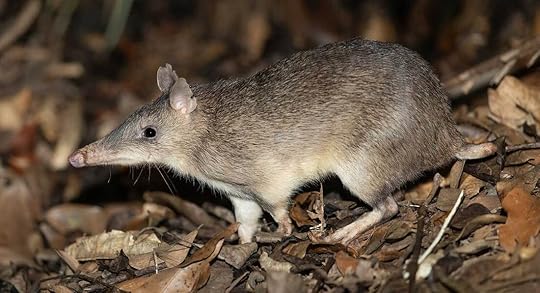
Photo Credit:
- Long-nosed bandicoot - JJ Harrison, CC BY-SA 4.0, via Wikimedia Commons
Samuel, the main character of Savage, encounters some very unusual bandicoots. No, not like Crash Bandicoot, the video game character, but these bandicoots are strange in a Stan-C-Smith-science-fiction kind of way.
Bandicoots are, of course, real animals. Some of them look kind of like rats, but they could hardly be more different. This photo is a long-nosed bandicoot.
Rats are rodents, which are placental mammals (more closely related to humans than to bandicoots). Bandicoots are marsupials (more closely related to kangaroos than to rats). Marsupials are unique among mammals in that their young develop mostly outside of the female's body instead of in a uterus inside the female's body. They are born VERY small, then they crawl to a pouch on the mother's abdomen, where they attach to a nipple and grow by feeding on mother's milk. Eventually, they get so big they can no longer stay in the pouch.
Bandicoots hop like rabbits when they run. They also have a high-pitched, bird-like call they use to locate each other.
Baby bandicoots are born after a very short gestation period—only 11 days (one of the shortest pregnancies of all mammals). Like with other marsupials, when they are born, they are tiny and they move out of the uterus and to the mother's pouch.
Bandicoots normally stand on all fours, and the mother's pouch is open facing the rear, to prevent dirt from entering the pouch as the mother digs for food.
And... male bandicoots have a "bifurcated" penis, with two ends. Why? Because the females have two vaginas. Actually, this is true of many marsupials... they have two vaginas, and two uteruses (uteri?). This allows marsupials to have several young (or litters of young) that are at different stages of development. For example, a kangaroo female can have a developing fetus in one uterus, a baby that is already born but is developing in her pouch, and another baby that is out of the pouch but is still young enough to be dependent. Pretty cool, huh?

Photo Credit:
- Long-nosed bandicoot - JJ Harrison, CC BY-SA 4.0, via Wikimedia Commons
Published on September 05, 2025 11:32
September 2, 2025
In our neck of the woods... Fawns and Doves
Two things I love about this time of the year in Missouri. First, the white-tailed deer fawns still have their spots (barely), but they are getting big enough that we occasionally see them out and about on their own. Remember, when fawns are small, they are much safer when they are alone, lying still in the vegetation of the forest floor, than when they are with their mother. The more hours per day the mother leaves them alone, the more likely the little fawns will survive. It's much more dangerous to be with the mother. Why? Because the mother is more visible, and more likely to draw the attention of predators. Which draws attention to the fawn. Most fawns taken by predators are those that are up and moving around, following their mother.
But now that fawns are large enough to outrun a coyote, it is safe for them to be with their mother (or even moving around on their own), and we see them more often. This fawn came into our driveway recently.
The second thing I love this time of the year is the soothing calls of mourning doves. For some reason, these haunting calls make me think of summers when I was a kid, staying in bed late on Saturday mornings and listening to the doves through the screens of the bedroom's open windows. It was a simpler time, so I try to rekindle those feelings whenever I hear them now. It seems we always have a few pairs of these birds near our house. Mourning doves are normally monogamous, mating for life (or until something happens to one of them).
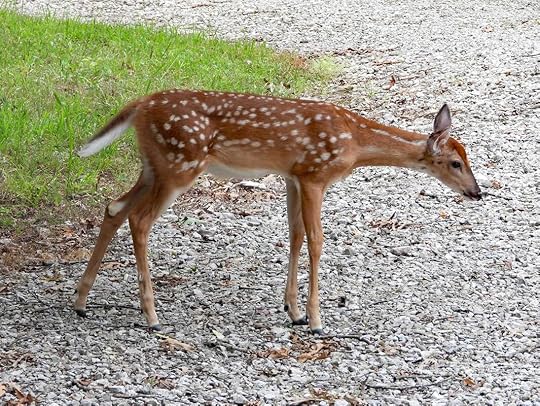
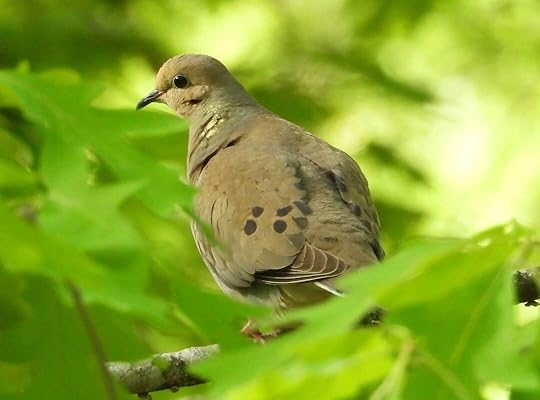
Photo Credits:
White-tailed deer fawn and mourning dove - Stan C. Smith
But now that fawns are large enough to outrun a coyote, it is safe for them to be with their mother (or even moving around on their own), and we see them more often. This fawn came into our driveway recently.
The second thing I love this time of the year is the soothing calls of mourning doves. For some reason, these haunting calls make me think of summers when I was a kid, staying in bed late on Saturday mornings and listening to the doves through the screens of the bedroom's open windows. It was a simpler time, so I try to rekindle those feelings whenever I hear them now. It seems we always have a few pairs of these birds near our house. Mourning doves are normally monogamous, mating for life (or until something happens to one of them).


Photo Credits:
White-tailed deer fawn and mourning dove - Stan C. Smith
Published on September 02, 2025 07:21
August 14, 2025
Tree Kangaroos - Info you never knew you needed
I've decided far too many people are unfamiliar with tree kangaroos. I intend to fix this problem. Tree kangaroos have been on my mind lately because I've been re-editing my Diffusion series for an audiobook narrator. A major character throughout the series is Mbaiso, a tree kangaroo with mysterious capabilities and intellect. Indeed, Mbaiso is not exactly what he seems to be.
Tree kangaroos are, however, real animals, and since they are under-appreciated, I'll give you a fun overview of these amazing creatures.
Yes, tree kangaroos are real! They live on the island of New Guinea, but also in very northern Australia and some of the Indonesian islands. Why are tree kangaroos so cool? Because they’re kangaroos—that live in trees. When Australian Aborigines and Papuan (New Guinea) natives told early European explorers about tree kangaroos, the explorers refused to believe the stories. You have to admit it seems pretty unlikely, right?
The first photo is a Goodfellows tree kangaroo.
Tree kangaroos are marsupials, in the genus Dendrolagus. There are about 14 different species, but this is one of very few types of large mammals with species still being discovered. Most tree kangaroos are about the size of a house cat. They are a fascinating example of divergent evolution (when groups of similar creatures become isolated and gradually diverge in form and function). Long ago, groups of ground-dwelling kangaroos became isolated in areas of dense tropical forest, as opposed to the open grasslands more typical for kangaroos. Once isolated in rainforest areas, they evolved the ability to climb trees.
These creatures eat, sleep, and breed in the treetops, but that doesn’t mean they live a comfortable existence. After all, breeding in the treetops might require some caution, right? Also, they're a tasty meal for their primary predator, the amethystine python (which has a habit of hugging much too tightly). And... natives hunt tree kangaroos for food In New Guinea: "The man who has successfully hunted a tree-kangaroo has greatness bestowed upon him. He has conquered the largest, most prestigious and human-like marsupial known to his people." (Tim Flannery, from the awesome book, Throwim Way Leg). And finally, they depend on pristine rainforest, and if you haven’t heard, rainforests are getting smaller every day (a real bummer).
Tree kangaroos are reclusive. Some are extremely rare and live in places so remote that they are unusually tame, as they have never learned to fear humans. Just a few years ago, National Geographic published an article about the Wondowoi Tree Kangaroo, a species that had not been spotted since 1929 (almost a hundred years ago). It was thought to be extinct, until an amateur botanist led an expedition into the nearly-impenetrable bamboo forests of the Wondiwoi Mountains of West Papua to find it. After much searching, he took the first ever photographs of this species.
The Papuan people of New Guinea have numerous ancient myths about tree kangaroos, some of which play a role in the Diffusion novels. For example, Mbaiso's name comes from a rare tree kangaroo, Dingiso mbaiso, which is revered by the local Moni people as an ancestor. When describing encounters with these animals, the tribesmen hunters say the creatures sit up, whistle, and hold up their paws in greeting. So the Moni believe the creatures are ancestor spirits who recognize them.
Another interesting story, this one about the Matschie’s Tree Kangaroo, is that the creature has a special power. If you think of the girl you love before you let your arrow fly to shoot this tree kangaroo, at the moment the arrow pierces the animal’s body, that’s when the girl will fall in love with you.
The second photo is the Matschie's tree kangaroo.
Tree kangaroos really are adapted to life in the trees. Compared to ground kangaroos, they have longer, curved nails for gripping the bark. Their hind feet are longer, and they have spongy, padded grips on their palms and the soles of their feet. Perhaps most striking is their tail. It is longer and heavier than those of ground kangaroos, which gives them better balance as they climb. When they climb straight up a tree trunk, they wrap their forearms around the tree and use their powerful hind legs to "hop" up the tree.
They are terrific jumpers. They can leap from one branch to another that is thirty feet (9m) below them. And, this may be hard to believe, but they can leap to the ground from as high as sixty feet (19m) without getting hurt! Considering adults can weigh 25 to 30 pounds (11 to 14kg), this is astounding.
As mentioned above, tree kangaroos are marsupials. You know what that means, right? It means they give birth to their babies very early, and then the babies develop in an external pouch. The babies are only the size of jellybeans at birth. At that point, the only parts of their external anatomy that are well developed are their hands and mouth. They use their hands to crawl to the pouch, then they attach their mouth to a nipple and hang on—for a long time. Astoundingly, baby tree kangaroos stay in the mother's pouch for up to 275 days. And then, after they come out, they are not weaned for up to another 240 days!
The third photo is a Bennett's tree kangaroo with a large baby, getting almost too big to fit in her pouch.
There you go. Now you can regale your friends with your tree kangaroo knowledge.
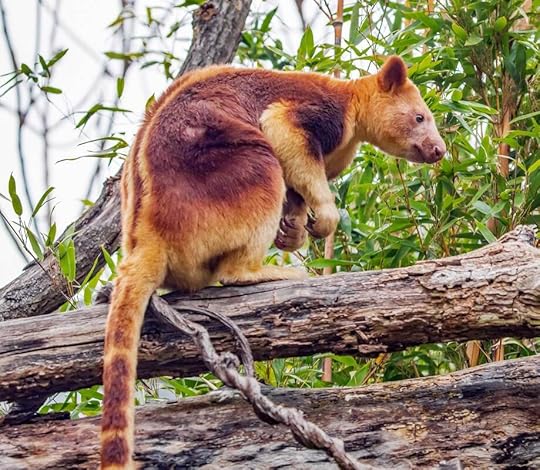
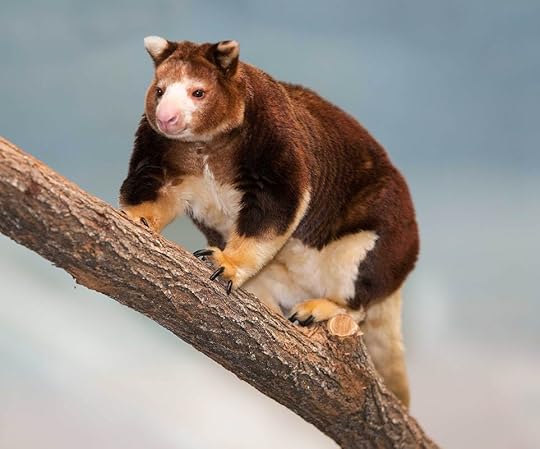
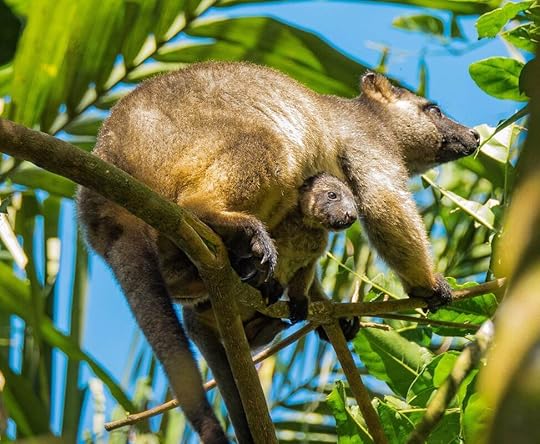
Photo Credits:
- Goodfellow's tree kangaroo - DepositPhotos
- Matchie's tree kangaroo - DepositPhotos
- Bennett's tree kangaroo with baby in pouch - DepositPhotos
Tree kangaroos are, however, real animals, and since they are under-appreciated, I'll give you a fun overview of these amazing creatures.
Yes, tree kangaroos are real! They live on the island of New Guinea, but also in very northern Australia and some of the Indonesian islands. Why are tree kangaroos so cool? Because they’re kangaroos—that live in trees. When Australian Aborigines and Papuan (New Guinea) natives told early European explorers about tree kangaroos, the explorers refused to believe the stories. You have to admit it seems pretty unlikely, right?
The first photo is a Goodfellows tree kangaroo.
Tree kangaroos are marsupials, in the genus Dendrolagus. There are about 14 different species, but this is one of very few types of large mammals with species still being discovered. Most tree kangaroos are about the size of a house cat. They are a fascinating example of divergent evolution (when groups of similar creatures become isolated and gradually diverge in form and function). Long ago, groups of ground-dwelling kangaroos became isolated in areas of dense tropical forest, as opposed to the open grasslands more typical for kangaroos. Once isolated in rainforest areas, they evolved the ability to climb trees.
These creatures eat, sleep, and breed in the treetops, but that doesn’t mean they live a comfortable existence. After all, breeding in the treetops might require some caution, right? Also, they're a tasty meal for their primary predator, the amethystine python (which has a habit of hugging much too tightly). And... natives hunt tree kangaroos for food In New Guinea: "The man who has successfully hunted a tree-kangaroo has greatness bestowed upon him. He has conquered the largest, most prestigious and human-like marsupial known to his people." (Tim Flannery, from the awesome book, Throwim Way Leg). And finally, they depend on pristine rainforest, and if you haven’t heard, rainforests are getting smaller every day (a real bummer).
Tree kangaroos are reclusive. Some are extremely rare and live in places so remote that they are unusually tame, as they have never learned to fear humans. Just a few years ago, National Geographic published an article about the Wondowoi Tree Kangaroo, a species that had not been spotted since 1929 (almost a hundred years ago). It was thought to be extinct, until an amateur botanist led an expedition into the nearly-impenetrable bamboo forests of the Wondiwoi Mountains of West Papua to find it. After much searching, he took the first ever photographs of this species.
The Papuan people of New Guinea have numerous ancient myths about tree kangaroos, some of which play a role in the Diffusion novels. For example, Mbaiso's name comes from a rare tree kangaroo, Dingiso mbaiso, which is revered by the local Moni people as an ancestor. When describing encounters with these animals, the tribesmen hunters say the creatures sit up, whistle, and hold up their paws in greeting. So the Moni believe the creatures are ancestor spirits who recognize them.
Another interesting story, this one about the Matschie’s Tree Kangaroo, is that the creature has a special power. If you think of the girl you love before you let your arrow fly to shoot this tree kangaroo, at the moment the arrow pierces the animal’s body, that’s when the girl will fall in love with you.
The second photo is the Matschie's tree kangaroo.
Tree kangaroos really are adapted to life in the trees. Compared to ground kangaroos, they have longer, curved nails for gripping the bark. Their hind feet are longer, and they have spongy, padded grips on their palms and the soles of their feet. Perhaps most striking is their tail. It is longer and heavier than those of ground kangaroos, which gives them better balance as they climb. When they climb straight up a tree trunk, they wrap their forearms around the tree and use their powerful hind legs to "hop" up the tree.
They are terrific jumpers. They can leap from one branch to another that is thirty feet (9m) below them. And, this may be hard to believe, but they can leap to the ground from as high as sixty feet (19m) without getting hurt! Considering adults can weigh 25 to 30 pounds (11 to 14kg), this is astounding.
As mentioned above, tree kangaroos are marsupials. You know what that means, right? It means they give birth to their babies very early, and then the babies develop in an external pouch. The babies are only the size of jellybeans at birth. At that point, the only parts of their external anatomy that are well developed are their hands and mouth. They use their hands to crawl to the pouch, then they attach their mouth to a nipple and hang on—for a long time. Astoundingly, baby tree kangaroos stay in the mother's pouch for up to 275 days. And then, after they come out, they are not weaned for up to another 240 days!
The third photo is a Bennett's tree kangaroo with a large baby, getting almost too big to fit in her pouch.
There you go. Now you can regale your friends with your tree kangaroo knowledge.



Photo Credits:
- Goodfellow's tree kangaroo - DepositPhotos
- Matchie's tree kangaroo - DepositPhotos
- Bennett's tree kangaroo with baby in pouch - DepositPhotos
Published on August 14, 2025 11:34
July 24, 2025
The Scariest Bird Ever - Terror Bird
The first novel in my Bridgers series takes place on a version of Earth where birds have evolved to fill all the niches that are filled by mammals on our Earth. However, in the past, our version of Earth has had some carnivorous birds that would give the monstrous birds in Bridgers 1 a run for their money. Including the Terror Birds. So, what the heck is a Terror Bird?
These were large flightless birds that lived in South America (and up into North America) between 62 million years ago and 15,000 years ago (although some evidence suggests they only survived until 1.8 million years ago). They were huge, fast, vicious predators. We have found evidence of about 25 species of terror birds.
Terror birds were big! They ranged in size from 3.3 to 9.8 feet (1 to 3 meters) tall. We think the larger ones weighed at least 330 pounds (150 kg). In fact, the largest bird skull ever found was a terror bird skull, 28 inches (71 cm) long, with a wicked-looking predator beak 18 inches (46 cm) long.
Terror bird is an appropriate name for these creatures. They must have struck terror into the mammals they preyed on. They had clawed wings that were more like arms (hey... just like the birds in Bridgers 1). They had huge, powerful talons (hind feet). They almost definitely grabbed their prey with their huge beaks. But CT scans of their skulls indicate they couldn't swing their prey side to side with much force. They had much more power in their up and down motion, and therefore we think they killed their prey by grabbing the creatures in their massive jaws and bashing them into the ground repeatedly until dead. Today, roadrunners, seriemas, and secretary birds still practice this feeding technique.
And terror birds were fast. Based on the birds' size and the structure of their bones, scientists believe they could run at least 35 miles per hour (56 km/h). It's possible these birds sometimes ate large mammals, but most likely they commonly ate rabbit-sized creatures that were easier and less dangerous to kill.
Scientists are pretty sure there is a descendant of terror birds still living today. It's called the Seriema. There are two species, and they live in South America (where most of the terror birds once lived). They stand a little less than a meter tall. They can fly for short distances, but they typically hunt while running. They even escape predators by running, and they can run fast. Like their terror bird ancestors did, they chase down prey, such as insects, lizards, snakes, frogs, birds, and rodents, then kill them by repeatedly slamming them against the ground with their beak.
The third photo below is a red-legged seriema.
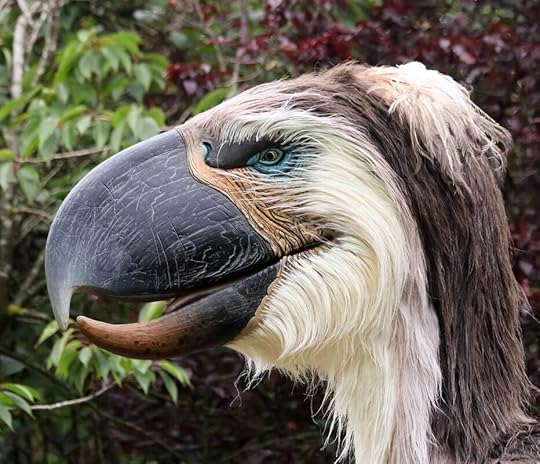
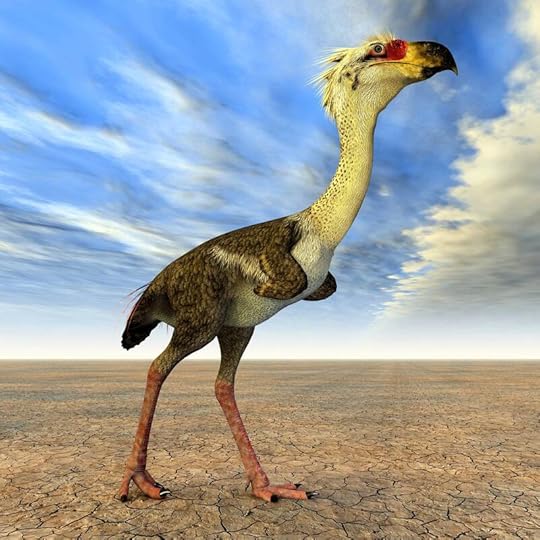
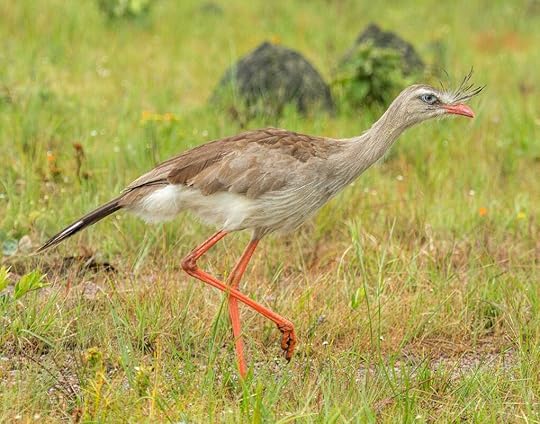
Photo Credits:
- Terror bird head - DepositPhotos
- Terror bird on dry lake bed - DepositPhotos
- Red-legged seriema - DepositPhotos
These were large flightless birds that lived in South America (and up into North America) between 62 million years ago and 15,000 years ago (although some evidence suggests they only survived until 1.8 million years ago). They were huge, fast, vicious predators. We have found evidence of about 25 species of terror birds.
Terror birds were big! They ranged in size from 3.3 to 9.8 feet (1 to 3 meters) tall. We think the larger ones weighed at least 330 pounds (150 kg). In fact, the largest bird skull ever found was a terror bird skull, 28 inches (71 cm) long, with a wicked-looking predator beak 18 inches (46 cm) long.
Terror bird is an appropriate name for these creatures. They must have struck terror into the mammals they preyed on. They had clawed wings that were more like arms (hey... just like the birds in Bridgers 1). They had huge, powerful talons (hind feet). They almost definitely grabbed their prey with their huge beaks. But CT scans of their skulls indicate they couldn't swing their prey side to side with much force. They had much more power in their up and down motion, and therefore we think they killed their prey by grabbing the creatures in their massive jaws and bashing them into the ground repeatedly until dead. Today, roadrunners, seriemas, and secretary birds still practice this feeding technique.
And terror birds were fast. Based on the birds' size and the structure of their bones, scientists believe they could run at least 35 miles per hour (56 km/h). It's possible these birds sometimes ate large mammals, but most likely they commonly ate rabbit-sized creatures that were easier and less dangerous to kill.
Scientists are pretty sure there is a descendant of terror birds still living today. It's called the Seriema. There are two species, and they live in South America (where most of the terror birds once lived). They stand a little less than a meter tall. They can fly for short distances, but they typically hunt while running. They even escape predators by running, and they can run fast. Like their terror bird ancestors did, they chase down prey, such as insects, lizards, snakes, frogs, birds, and rodents, then kill them by repeatedly slamming them against the ground with their beak.
The third photo below is a red-legged seriema.



Photo Credits:
- Terror bird head - DepositPhotos
- Terror bird on dry lake bed - DepositPhotos
- Red-legged seriema - DepositPhotos
Published on July 24, 2025 10:38



